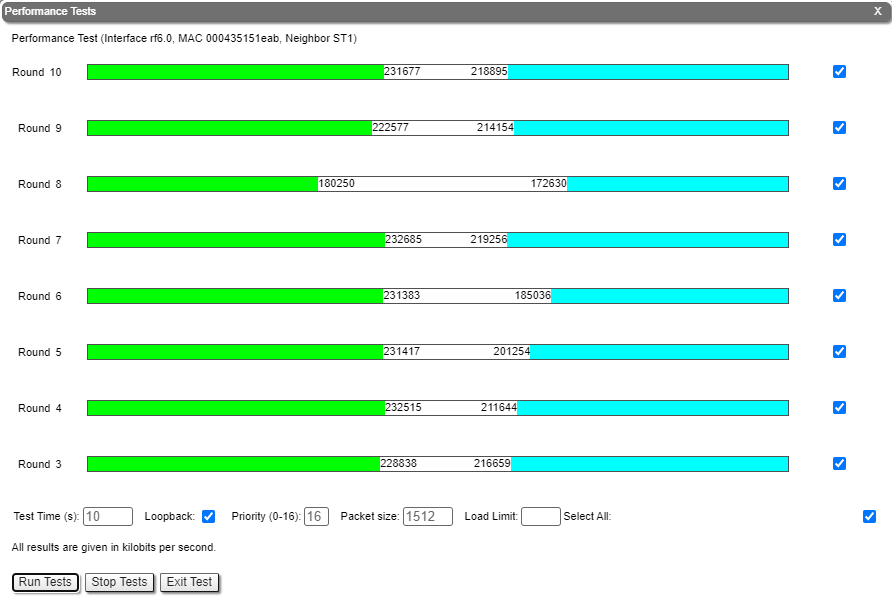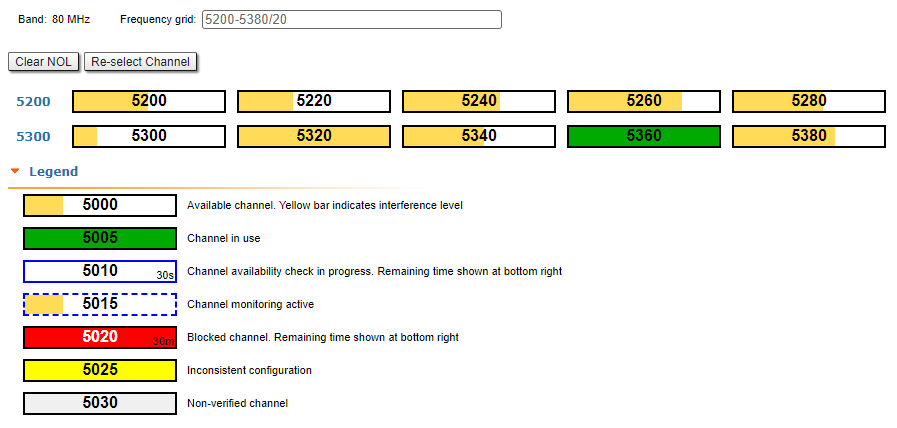InfiLINK Evolution and InfiMAN Evolution - initial link configuration and installation
Parameter estimation and optimization of the link
account course progress
Wireless link statistic
To assess the wireless link state in the web interface, go to the "Device status" section - "Link statistics for the rf6.0 interface. Targeted parameters:
- Retries Rx/Tx: maximum 5 %.
- EVM Rx/Tx: not less than 21 dB in absolute value.
- SNR Rx/Tx: not less than 27 dB.
If these conditions are met and the maximum bitrate is reached, the wireless connection quality is good.
Performance tests
The throughput test can be performed with the "Performance Tests" tool built into the web interface, in the section "Device status" → "Link statistics for the rf6.0 interface". This tool generates test traffic between the devices and it allows to obtain data about the real link throughput both in one direction and in a two-way manner. The throughput evaluation is performed using traffic with the specified priority without taking into account the service traffic required to maintain the link operational. To exclude the influence of the data traffic on the test's result, it is recommended to set the highest priority for the test traffic (at least 15), performance tests are always performed on the highest modulation.

Optimization of the link
Autobitrate and ATPC
To keep a balance between the wireless link's performance and the retries number, we recommend to always set the "Bitrate" parameter to "Auto" mode. Also enable the automatic transmit power control (ATPC) in order to increase the operational life of the devices.
Frame size
If the device has a software version with TDMA technology support, make sure that the selected frame size ensures the best performance for your wireless system. A short frame will transmit less payload than a long one, however it ensures a smaller delay. A detailed description of the frame sizes in the TDMA technology is available in the "TDMA and Polling: Application features" article.
Packet retries management
The "Turbo" mode is available in the TDMA software version, which allow to increase the wireless link throughput in case that the degradation is caused by a large number of errors in the radio.
Detailed information about the radio parameter configuration via the web interface is available in the "Link Settings" article or via CLI in the articles: "mint command (TDMA version)" and "rfconfig command (TDMA version)".
Dynamic Frequency Selection (DFS)
Dynamic Frequency Selection is an interference mitigation technique that aims to:
- Protect the radar systems by avoiding co-channel operation with the broadband wireless systems
- Ensure a uniform distribution of the applications across the spectrum (according to the EN 301 893 standard, a uniform spreading is required across 5150 MHz to 5350 MHz and 5470 MHz to 5725 MHz)
The standards specify the performance requirements for the wireless systems in order to avoid the interference with the radars but do not define how to implement DFS practically. Vendors have the responsibility to implement DFS using their specific means to comply with the requirements of the standard. Detection requirements:
- Channel Availability Check - when initially powered on, or in case that radar is detected on the operating channel, a frequency scan must be performed to determine the available channels
- In-service monitoring - the operating channel is constantly monitored for the presence of radar signals (the detection thresholds are the same as in case of CAC)
- In-service monitoring is performed in between each data transmission, and its duration is of µs order
- Off-channel Channel Availability Check - in addition to CAC, DFS can also decide to select a better channel (less interfered) if the SNR of the operational channel falls below a certain threshold; this operation requires link interruption as the radio module can either transmit/receive data or perform the medium scan
DFS technology implementation in the InfiLINK Evolution, InfiMAN Evolution families devices has following options:
- In "DFS only" mode, the DFS system monitors interferences but does not perform radar detection.
- In "DFS with Radar Detection" mode, the DFS system monitors interferences and performs radar detection.
Automatic frequency selection configuration
At the Slave device:
- Go to the Basic Settings section, then to Link settings, set the Frequency to "Auto".
- In the Custom Frequency Grid, change the range of the available channels for the selected bandwidth so that only 10 frequencies are available (choose the least interfered part of the range) and apply the configuration.
At the Master device:
- Go to the Basic Settings section, then to Link settings and:
- Select "DFS with Radar Detection" or "DFS only" for the DFS parameter and "Auto" for Frequency.
- In the Custom Frequency Grid, change the range of the available channels for the working bandwidth as well as only 10 frequencies to be available (chose the less interfered part of the range) and apply the configuration.


The initial Channel Availability Check takes 3 seconds per each frequency; thus for the 10 available frequencies, the initial CAC must take 30 seconds, so the link is established in between 30 and 40 seconds because the Slave unit scans too each frequency in 1 second to find the Master unit.
